The Romance of Space Travel: On the Sexual Iconography of Spacecraft
From: University of Michigan | By: Eric S. Rabkin Eric Rabkin (right), professor of English at the University of Michigan, turns an eye to popular culture to look at America's romance with space exploration over the course of the past century. Providing a close reading of science fiction literature and movies, Rabkin examines the familiar images of spacecraft — probing rockets, invading saucers, and contemporary space stations — and their psychosexual dimension in the American cultural imagination.
Eric Rabkin (right), professor of English at the University of Michigan, turns an eye to popular culture to look at America's romance with space exploration over the course of the past century. Providing a close reading of science fiction literature and movies, Rabkin examines the familiar images of spacecraft — probing rockets, invading saucers, and contemporary space stations — and their psychosexual dimension in the American cultural imagination. It is often embarrassingly easy — and often, I think, quite correct — to see rocket ships, especially in science fiction (SF), as phallic symbols. Rocketry pioneer Konstantin Tsiolkovsky, after all, called his classic article on space travel "The Probing of Space by Means of Jet Devices" (written 1898; published 1903). Ray Bradbury, whether consciously or not, clearly saw rocket ships as phallic in the last paragraph of "Rocket Summer," the one-page opening scene-setter for his influential composite novel called The Martian Chronicles (1950):
The rocket lay on the launching pad, blowing out pink clouds of fire and oven heat. The rocket stood in the cold winter morning, making summer with every breath of its mighty exhausts. The rocket made climates, and summer lay for a brief moment upon the land....

German V-2 rocket launch.
One cannot help but notice the repetition of "lay," the chugging heat of the rocket, and its erection from "lay" to "stood." It is no wonder then, as SF writer Poul Anderson has noted in Brian Ash's Visual Encyclopedia of Science Fiction (1977), that "the fashion among intellectuals is to deride the rocket as a phallic symbol." But this derision arises from a failure to understand the complexities of the iconography of spacecraft.
A feminist psychoanalyst might smirk at Anderson's apparently unself-conscious use of the term "deride"; in her contribution to Reginald Bretnor's Science Fiction: Today and Tomorrow (1974), feminist SF author Anne McCaffrey definitely does smirk more generally:
[In pre-1960s SF, the] girl was still a "thing," to be "used" to perpetuate the hero's magnificent chromosomes. Or perhaps, to prove that the guy wasn't "queer." I mean, all those men locked away on a spaceship for months/years at a time. I mean . . . and you know what I mean even if I couldn't mention it in the sf of the '30s and '40s.Of course, McCaffrey's target is either a homosexual or an adolescent kind of sexuality, or both, but this is perhaps appropriate to the largely male adolescent audience of the pulp magazines of the 1920s through the 1950s. Freud, however, suggests no such sexual limitations to his concept of phallic symbol enunciated in The Interpretation of Dreams (1900):
All elongated objects, sticks, tree-trunks, umbrellas (on account of the opening, which might be likened to an erection), all sharp and elongated weapons, knives, daggers, and pikes, represent the male member. A frequent, but not very intelligible symbol for the same is a nail-file (a reference to rubbing and scraping?).Anderson, too, seems responsive to a more adult and certainly more heterosexual power. Anderson continues:
And in truth, when a big one rises, like Apollo Seventeen which filled the whole night with glory, the experience can be as intense for the onlooker as any climax between man and woman. [emphasis added]It is crucial to note that Anderson's is a vision of the rocket ship seen from the outside, not the rocket ship as inhabited. The question of the psychological significance of the rocket is, as even Anderson notes, much more complex than the single word "phallic" suggests. Again Anderson:
Yet physical sex is just a part of sexual love; there are also tenderness, loyalty, shared laughter, shared grief, shared discovery, the creation of new life and the nurturing of it.
Note that these matters need not be gender-restricted nor even necessarily involved with eros.
In The Known and the Unknown: The Iconography of Science Fiction (1979), Gary Wolfe begins his chapter called "Icon of the Spaceship" by quoting from the end of Roland Barthes' chapter in Mythologies (1957) on Jules Verne's submarine Nautilus:
The basic activity in Jules Verne, then, is unquestionably that of appropriation. The image of the ship, so important in his mythology, in no way contradicts this. Quite the contrary: the ship may well be a symbol for departure; it is, at a deeper level, the emblem of closure. An inclination for ships always means the joy of perfectly enclosing oneself, of having at hand the greatest number of objects, and having at one's disposal an absolutely finite space. To like ships is first and foremost to like a house, a superlative one since it is unremittingly closed, and not at all vague sailings into the unknown: a ship is a habitat before being a means of transport. And sure enough, all the ships in Jules Verne are perfect cubby-holes, and the vastness of their circumnavigation further increases the bliss of their closure, the perfection of their inner humanity.
Although neither Wolfe nor Barthes mentions Freud in this regard, Wolfe's analysis, in fact, takes up precisely the point with which Freud immediately continues after defining phallic symbols:
Small boxes, chests, cupboards, and ovens correspond to the female organ; also cavities, ships, and all kinds of vessels. A room in a dream generally represents a woman; the description of its various entrances and exits is scarcely calculated to make us doubt this interpretation. The interest as to whether the room is "open" or "locked" will be readily understood in this connection.
Wolfe views the ship not from the outside as a "probe" but from the inside as a long-term habitat that may — or may not — deliver us. As habitat, the spaceship becomes either a spacestation, that is, something effectively seen as not moving, an Erector Set conflation of domes and ladders like the artificial world of the film Silent Running (1972) or, to borrow James Blish's term, a "city in flight," that is, a perfect, space-faring metropolis, from the Greek meter, meaning "mother" and polis, meaning "city." In SF, the notion of ship as womb has obvious merit when we encounter one of the so-called "generation ships" in which humans spend lifetimes traveling to the stars, children succeeding parents over eons in an attempt, as in Robert A. Heinlein's Orphans of the Sky (original stories published 1941), to reach our species' maturity and a new home among the stars. Wolfe concludes: "The spaceship, in other words, may be a womb, a house, a social club, a city, or even a self-enclosed world, but it is seldom the phallic symbol many have made it out to be." He is right about ship-as-womb, but in his use of the term "seldom," Wolfe, I think, is wrong about the ship-as-phallus because in most cases we see spaceships from without.
In sum, the psychosexual charge of the spaceship is quite dependent on whether we view it from without (male) or from within (female), on whether we see it as a machine for thrusting and returning (adult/phallic) or as a machine for leaving/becoming (juvenile/womblike). In his Voyage dans la lune (1902), Georges Méliès, one of the world's first great filmmakers, understood this connection between sexuality and viewpoint perfectly, and seems also to have understood Freud's association of phallic symbols with "all sharp and elongated weapons."
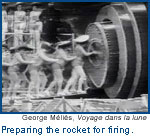 In this still from his movie, based very loosely on Verne's novel of the same name, Méliès presents pseudo-military maidens in the service of an enormous rifle which, the audience knows, has only male voyagers in its hollow, loaded bullet. This association of rockets with the military, a traditionally male domain, is typical in cinema, and made explicit in the firing of the phallic rifle/rocket.
In this still from his movie, based very loosely on Verne's novel of the same name, Méliès presents pseudo-military maidens in the service of an enormous rifle which, the audience knows, has only male voyagers in its hollow, loaded bullet. This association of rockets with the military, a traditionally male domain, is typical in cinema, and made explicit in the firing of the phallic rifle/rocket.
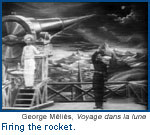 Even more advanced than his apparent understanding of Freud was Méliès' understanding and critique of "appropriation," the term Barthes used for Verne's construction of his diverse exploration vehicles. Méliès offers us a premonition of a tenet of post-modernism, that the appropriating gaze of the film audience, like the appropriating gaze of the male, constitutes a punishable invasion.
Even more advanced than his apparent understanding of Freud was Méliès' understanding and critique of "appropriation," the term Barthes used for Verne's construction of his diverse exploration vehicles. Méliès offers us a premonition of a tenet of post-modernism, that the appropriating gaze of the film audience, like the appropriating gaze of the male, constitutes a punishable invasion.
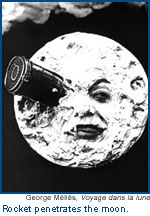 A subtle irony here is that the Man in the Moon Méliès depicts as half-blinded by the probing military men of Earth in their rifle-bullet rocket is, unbeknownst to his audience, the moving picture director Méliès himself.
A subtle irony here is that the Man in the Moon Méliès depicts as half-blinded by the probing military men of Earth in their rifle-bullet rocket is, unbeknownst to his audience, the moving picture director Méliès himself.
In less complex ways, too, the rocket typically has been a masculine and often military symbol. The German V-2, the so called "buzz bomb" that screamed in over London during World War II to send the English cowering underground, was pictured, like Bradbury's rocket, rising on its tail of potent flame.
 Early in the "Space Race" between the US and the Soviet Union, not only was America unmanned by the Soviet success with Sputnik, the world's first successfully launched artificial satellite (October 4, 1957), but by the repeated failure of the American rocket, the Vanguard, to "get it up." Pictures showing Vanguard's exploding, crumbling and falling down instead of taking off were public icons of national shame.
Early in the "Space Race" between the US and the Soviet Union, not only was America unmanned by the Soviet success with Sputnik, the world's first successfully launched artificial satellite (October 4, 1957), but by the repeated failure of the American rocket, the Vanguard, to "get it up." Pictures showing Vanguard's exploding, crumbling and falling down instead of taking off were public icons of national shame.

Shuttle Columbia launches.
When America finally got it right, pictures began to show oversized parts on the blasting rockets. The shuttle Columbia is typical. The comparatively small shuttle is plastered to the huge, firing assemblage dominated by its central pointy tower, which, in fact, is nothing but a gigantic fuel tank, pure potency. Compared to that, merely human men either crouch or worship, vainly striving to gaze at a power that will quickly elude them on its defiant, blazing column.
 In plotting the romantic iconography of space travel, as important as the distinction between viewing spaceships from outside or inside is the distinction between "our" spacecraft and "their" spacecraft. Our spacecraft, human spacecraft, as we have seen, are typically rocket ships, long, hard, pointy things shooting fire; their spacecraft, alien spacecraft, as we can all remember, are typically flying saucers, round, trembling, curvy things humming unseen energies. Our rockets go out; their saucers come in. Our rockets assault planets; their saucers assault our bodies. Already in H. G. Wells' The War of the Worlds (1898), spherical ships which we mistake at first for meteors, crash, create pits, and "unscrew" to send up slender shining stalks reminiscent of Medusa's hair and bearing "heat rays" that obliterate human soldiers who dare to look upon them. But in Steven Spielberg's Close Encounters of the Third Kind (1977; tagline: "We are not alone"), the enormous yonic saucer descends peacefully, lowers its gangway to reveal blinding light, and androgynous aliens come to walk among us, taking the faithful back into the ship, which rises in stately fashion, which we view from above, the upper surface a coruscating city of towers, a Newer Jerusalem, the latest bride of Christ.
In plotting the romantic iconography of space travel, as important as the distinction between viewing spaceships from outside or inside is the distinction between "our" spacecraft and "their" spacecraft. Our spacecraft, human spacecraft, as we have seen, are typically rocket ships, long, hard, pointy things shooting fire; their spacecraft, alien spacecraft, as we can all remember, are typically flying saucers, round, trembling, curvy things humming unseen energies. Our rockets go out; their saucers come in. Our rockets assault planets; their saucers assault our bodies. Already in H. G. Wells' The War of the Worlds (1898), spherical ships which we mistake at first for meteors, crash, create pits, and "unscrew" to send up slender shining stalks reminiscent of Medusa's hair and bearing "heat rays" that obliterate human soldiers who dare to look upon them. But in Steven Spielberg's Close Encounters of the Third Kind (1977; tagline: "We are not alone"), the enormous yonic saucer descends peacefully, lowers its gangway to reveal blinding light, and androgynous aliens come to walk among us, taking the faithful back into the ship, which rises in stately fashion, which we view from above, the upper surface a coruscating city of towers, a Newer Jerusalem, the latest bride of Christ.
Saucers, in other words, may carry any of the attributes traditionally associated with the female: virgin, lover, whore, witch who would eat you (Wells' Martians are vampires) and mother who would nurture you so that eventually you can grow up and leave home (as in Clarke's Childhood's End [1953]).
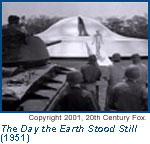 This conflict between "our" outgoing, macho rockets and "their" incoming female saucers is made vivid in Robert Wise's Cold-War classic, The Day the Earth Stood Still (1951). Here the humans are represented by military men drawn around the yonic saucer. The spacecraft opens and a robot descends, our cannon pointed at their slot. The setting, the National Mall in Washington, D.C., is both a possible Paradise Regained and the heart of dominant male power. The film is a politically liberal cry for peace that explores confusions then (and now?) current in the US. Michael Rennie plays Klaatu, a humanoid who delivers the message that the Earth must stop developing atomic weapons or the civilized remainder of the galaxy will be forced to destroy it. Rennie is shot, but, it turns out that Gort, the robot, is the real messenger, and one able to return Klaatu to life once a human woman gives Gort the famous message, "Klaatu borada nikto." We may not know exactly what it means, but it brings life within the saucer-womb.
This conflict between "our" outgoing, macho rockets and "their" incoming female saucers is made vivid in Robert Wise's Cold-War classic, The Day the Earth Stood Still (1951). Here the humans are represented by military men drawn around the yonic saucer. The spacecraft opens and a robot descends, our cannon pointed at their slot. The setting, the National Mall in Washington, D.C., is both a possible Paradise Regained and the heart of dominant male power. The film is a politically liberal cry for peace that explores confusions then (and now?) current in the US. Michael Rennie plays Klaatu, a humanoid who delivers the message that the Earth must stop developing atomic weapons or the civilized remainder of the galaxy will be forced to destroy it. Rennie is shot, but, it turns out that Gort, the robot, is the real messenger, and one able to return Klaatu to life once a human woman gives Gort the famous message, "Klaatu borada nikto." We may not know exactly what it means, but it brings life within the saucer-womb.
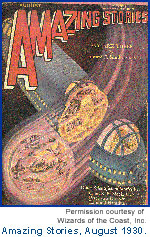 A less hopeful vision of the conflict between our outgoing rockets and their incoming saucers is visible on the cover of Amazing Stories for August 1930, which depicts a transparent spherical spacecraft slicing the end off a pointy human space liner. Apparently the Earthly "battle of the sexes" replays itself iconographically throughout the universe. But must it?
A less hopeful vision of the conflict between our outgoing rockets and their incoming saucers is visible on the cover of Amazing Stories for August 1930, which depicts a transparent spherical spacecraft slicing the end off a pointy human space liner. Apparently the Earthly "battle of the sexes" replays itself iconographically throughout the universe. But must it?
For "romance," as it is most frequently understood, to exist, we typically need both a male and a female. In contemplating the compelling nature of "the romance of space travel," perhaps it should not then be surprising to learn that the very words "space" and "travel" have at root an iconographic "female" and "male" sense. According to Joseph T. Shipley (The Origins of English Words: A Discursive Dictionary of Indo-European Roots, 1984), "space" derives from Indo-European spei, "broad, spread out," and "travel" from pag, "fix, fasten, bind" through "tripalium," a torture with three stakes, and "travail," "as were all early trips."
Is there a way beyond the conflict of male and female? In "The Million Year Picnic," the first section of The Martian Chronicles to be written and the last in order as published in the finally assembled book, Bradbury's refugee Earth family goes to Mars and blows up their own rocket. The father, a "former state governor," tells his family thatI'm burning a way of life.... Science ran too far ahead of us too quickly and the people got lost in a mechanical wilderness, like children making over pretty things, gadgets, helicopters, rockets; emphasizing the wrong items, emphasizing machines instead of how to run the machines.... We were lucky [to escape the nuclear war back on Earth]. There aren't any more rockets left. It's time you knew this isn't a fishing trip at all.... Now I'm going to show you the Martians.
At that point, traveling not by ship but by boat on the Martian canal, the father has his children look at the water's surface. "The Martians stared back up at them for a long, long silent time from the rippling water...." And thus ends the novel.
Boats are for going out and back. Fishermen use them to harvest rivers and seas. They are nests, habitations, female, and named as such. They will not do for crossing oceans. Ships, including spaceships and Bradbury's rockets, are for seeking new lands, but they may not sustain us, and may even need to be destroyed. Is there any way for humans to succeed in the ocean of space without giving themselves up utterly to the alien, without destroying their masculinity? Can we somehow harmonize the male and the female in space travel?
Yes, it seems, by having neither "ours" nor "theirs," by having no home planet to leave or alien planet to exploit. Those spacecraft that are built in space and designed to stay in space, like Gene Roddenberry's Enterprise (Star Trek, first broadcast 1966) and Stanley Kubrick's Discovery (2001: A Space Odyssey, 1968) assemble both pointy and curvy parts, phallus and yoni, sticks and spheres, and form possible habitable worlds, generation ships with no mission other than to generate, to celebrate life and growth. This harmony, in fact, underlies the real vision of the International Space Station, a current effort by many of Earth's nations to cooperate in building, inhabiting and learning from a shared experience in space, neither leaving nor arriving, neither male nor female, but offering a conjunction of all, just as the U.S. National Aeronautics and Space Administration pictures the ISS presiding over a world where land masses join and the very land and sea harmonize.

International Space Station.
To have what the rocket ship promised, the icons seem to say, we must somehow learn to put its promise behind us, to grow from romance to something deeper and more lasting. And if the rocket ship brings us there, to that point of possibility and decision, then the journey will have been worthy indeed.